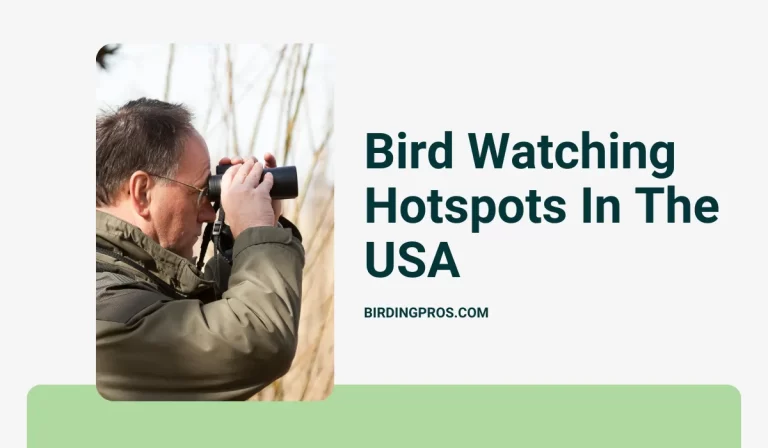9 Top Birding Hotspots in Texas: Spot Amazing Birds
Texas is a birdwatcher’s dream come true, offering an incredible variety of landscapes that attract hundreds of bird species.
Lone Star State has a wealth of opportunities from the coastline to the deserts and the wetlands to the mountains, there’s always something new to discover.
Let’s take a deeper dive into some of the top birding hotspots in Texas and what makes them special.
Table of Contents
Coastal Hotspots
Texas’ Gulf Coast is one of the best places in the U.S. for birdwatching, especially during migration seasons. The mix of salt marshes, sandy beaches, and coastal prairies make this area a magnet for birds.
| Location | Best Time to Visit | Key Bird Species |
|---|---|---|
| High Island | Spring (March-May) | Warblers, tanagers, orioles, herons |
| Bolivar Flats | Year-round | Shorebirds, pelicans, skimmers |
| Aransas National Wildlife Refuge | Winter (November-March) | Whooping cranes, roseate spoonbills, sandhill cranes |
- High Island is famous among birdwatchers during the spring migration. It’s a stopping point for birds that are exhausted after their long flight across the Gulf of Mexico. You can see brightly colored warblers, tanagers, and orioles here. It’s also a great spot to catch sight of herons and other waders in the nearby marshes.
- Bolivar Flats is a year-round destination known for its large flocks of shorebirds. Pelicans, skimmers, and plovers can be spotted here, especially during low tide. Birdwatchers can also witness incredible numbers of migratory species during the spring and fall.
- Aransas National Wildlife Refuge is world-famous as the winter home of the endangered Whooping Crane. If you visit in winter, you’ll see these magnificent birds along with roseate spoonbills and sandhill cranes. It’s a must-see for any serious birder.
Desert and Mountain Regions

The western part of Texas offers an entirely different experience, with deserts and rugged mountain ranges providing habitats for rare and unique species.
The high elevation, combined with the open skies, makes this region perfect for spotting birds of prey and elusive species that thrive in these tough environments.
| Location | Best Time to Visit | Key Bird Species |
|---|---|---|
| Big Bend National Park | Spring and Fall | Colima warbler, varied bunting, zone-tailed hawk |
| Davis Mountains State Park | Year-round | Montezuma quail, hummingbirds, Mexican jay |
| Seminole Canyon State Park | Year-round | Cactus wren, black-throated sparrow, white-throated swift |
Big Bend National Park is a hotspot for birdwatchers looking for desert-dwelling species. The park is home to the Colima warbler, which nests here during the spring.
You might spot the striking varied bunting, zone-tailed hawks, and a variety of hummingbirds. The park’s remote location also offers stunning vistas as a backdrop to your birdwatching adventures.
Davis Mountains State Park is another top spot, especially for those looking to see Montezuma quails and Mexican jays.
This state park is a great year-round destination thanks to its cooler temperatures at higher elevations, making it a refuge for species that can’t take the Texas heat.
Seminole Canyon State Park is home to birds like the cactus wren and black-throated sparrow. You can also find species like the white-throated swift, which nest along the canyon walls. This park offers an excellent blend of birding and hiking through stunning desert scenery.
Read More: How Much Bigger are Ravens Than Crows? See The Comparison
Wetlands and Prairies
Wetlands and prairies are abundant in central and eastern Texas, creating a haven for waterbirds and grassland species.
These regions are crucial for migratory birds that need rest and food on their journey, as well as for those that call Texas home year-round.
| Location | Best Time to Visit | Key Bird Species |
|---|---|---|
| Anahuac National Wildlife Refuge | Year-round | Ducks, geese, purple gallinule, herons |
| Laguna Atascosa National Wildlife Refuge | Year-round | Green jay, plain chachalaca, aplomado falcon |
| Brazos Bend State Park | Year-round | Waterbirds, woodpeckers, owls, herons |
Anahuac National Wildlife Refuge is a massive expanse of marshes, swamps, and grasslands. During winter, the refuge becomes a haven for migratory waterfowl like ducks and geese. Purple gallinules and herons can also be found here year-round, making it a great spot to explore anytime.
Laguna Atascosa National Wildlife Refuge is famous for its green jays and aplomado falcons. This area is home to a number of tropical species that don’t live anywhere else in the United States, giving it a unique feel for birdwatchers who want to see something out of the ordinary.
Brazos Bend State Park is a perfect destination for birding near Houston. It offers easy access to a variety of waterbirds, woodpeckers, and owls.
The park’s wetlands and lakes are home to herons and egrets, while the surrounding woodlands offer a chance to spot different species of woodpeckers and screech owls.
Tips for Birding in Texas
Bird watching in Texas can be a rewarding experience if you’re prepared. Here are some helpful tips to get the most out of your birding adventures:
Bring the right gear: Binoculars are essential for spotting birds from a distance. A good field guide will help you identify different species. Don’t forget a camera to capture your sightings!
Dress appropriately: Texas weather can change quickly, so dress in layers. Sturdy, comfortable shoes are a must for hiking through different terrains, from rocky trails to marshy wetlands.
Stay hydrated: Texas can get extremely hot, especially in summer. Make sure to bring plenty of water with you to stay hydrated during your birding trips.
Respect wildlife: Always keep a safe distance from birds and never disturb their nests. Some species are sensitive to human activity, so it’s important to observe without interfering.
Join a local birding group: Local birding groups are a great resource for finding the best spots and learning from experienced birders. They can also offer tips on recent sightings and migration patterns.
Final Thoughts
Texas offers incredible bird watching opportunities year-round. Whether you’re exploring the Gulf Coast for migratory shorebirds, hiking through the desert in search of rare species, or spotting waterfowl in the wetlands, Texas has something for every bird lover.
With so many diverse ecosystems, you’ll be able to discover new species and enjoy breathtaking landscapes with every trip. Happy birding!






